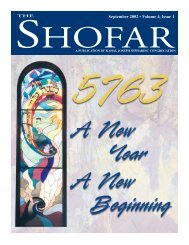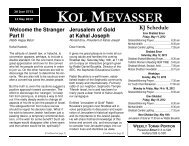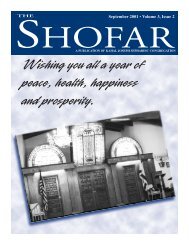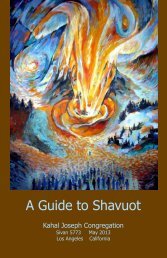Create successful ePaper yourself
Turn your PDF publications into a flip-book with our unique Google optimized e-Paper software.
By Nadine Dabby<br />
The Exploratorium is one of the few places<br />
that I know of where children and adults<br />
alike are encouraged to touch and play<br />
with everything. Even the water fountain is a lesson<br />
waiting to be discovered (when you drink the<br />
water music plays, but when you let the water<br />
run it doesn’t, that is because it was wired so that<br />
the fountain drinker completes the low-voltage<br />
electrical circuit that powers the music).<br />
Founded in the 1960s, the San Francisco science<br />
museum was designed to educate people about science<br />
by encouraging them to seek out the reasons<br />
why the phenomena on display works. In essence,<br />
that is science—the creative process of asking questions<br />
about the world around you and finding ways<br />
to test your explanations. And that is the one thing<br />
most K-12 schools fail to convey: the idea of being<br />
in a room full of ideas and objects and thoughts and<br />
allowing ones imagination to run wild.<br />
In fact, thanks to recent legislation, such as the<br />
No Child Left Behind Act, teachers across America<br />
are forced to spend most of their time teaching<br />
toward the standardized tests that determine their<br />
funding. Couple this with the size of classes, the<br />
load of 5 classes a day, the low pay and the already<br />
dire funding prospects and it is easy to see why<br />
America is losing ground to China and India in<br />
terms of developing the next generation of scientists<br />
and idea makers.<br />
For the last two summers I have had the privilege<br />
of visiting the Exploratorium as a summer fellow<br />
and participant of the museum’s Teacher Institute,<br />
whose mission is to teach teachers to bring the<br />
hands-on, engaging exhibits and ideas into the<br />
classroom (on a shoe-string budget). I have had the<br />
experience of spending time with 30-40 teachers<br />
and seeing the effort that the good ones put into<br />
their work. And this is what I have to say to you,<br />
the parent:<br />
One of the most shocking things I have discovered<br />
is that not only are teachers without a scientific<br />
On Education<br />
background (beyond high school-level biology)<br />
thrust into positions where they must teach math<br />
and science, but these teachers are sometimes<br />
forced to teach outdated material (that is factually<br />
incorrect) because the state standardized tests have<br />
not been updated in years.<br />
Don’t trust your school system with your children’s<br />
education. Studies have shown that the most<br />
successful students are the ones whose parents are<br />
involved in their education by either creating an<br />
environment in which science or literature or politics<br />
is discussed in the home or by parents who make<br />
sure their kids are getting a complete education.<br />
Most teachers are very good people with good<br />
intentions who just may not have the time or<br />
resources to combat this problem. That is why I<br />
encourage you to get involved in your kids’<br />
schools, get involved in the community. You may<br />
find that this activity will teach you a thing or two.<br />
Congratulations to<br />
Rabbi Haim & Edna Ovadia on<br />
The occasion of their son Ariel’s<br />
Forth coming Marriage to Esther<br />
Rivka and Albert Gad<br />
And family<br />
SEPTEMBER 2007 9 / THE SHOFAR












